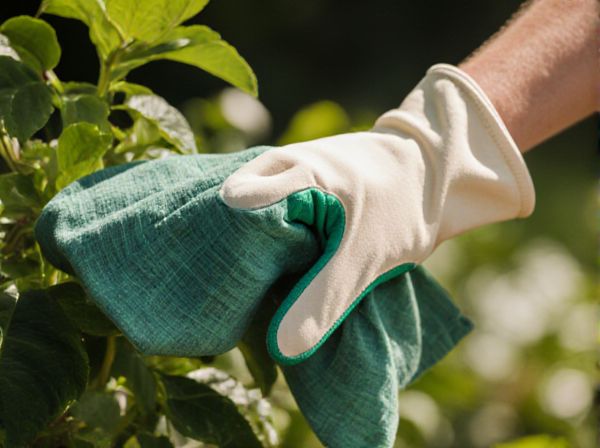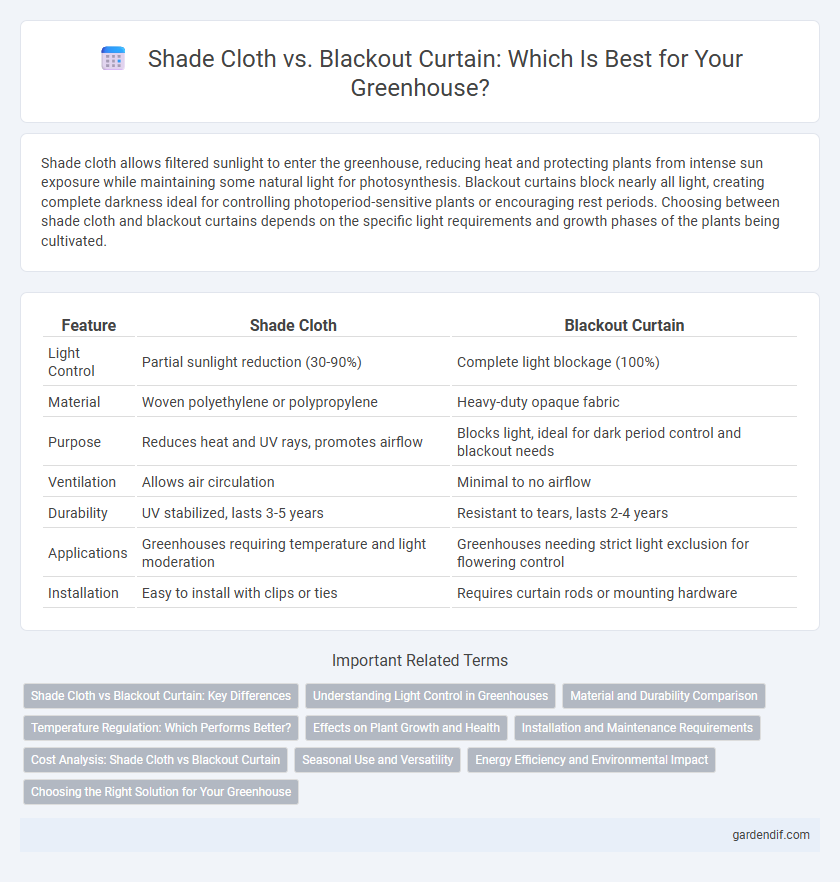
Shade cloth vs Blackout curtain Illustration
Shade cloth allows filtered sunlight to enter the greenhouse, reducing heat and protecting plants from intense sun exposure while maintaining some natural light for photosynthesis. Blackout curtains block nearly all light, creating complete darkness ideal for controlling photoperiod-sensitive plants or encouraging rest periods. Choosing between shade cloth and blackout curtains depends on the specific light requirements and growth phases of the plants being cultivated.
Table of Comparison
| Feature | Shade Cloth | Blackout Curtain |
|---|---|---|
| Light Control | Partial sunlight reduction (30-90%) | Complete light blockage (100%) |
| Material | Woven polyethylene or polypropylene | Heavy-duty opaque fabric |
| Purpose | Reduces heat and UV rays, promotes airflow | Blocks light, ideal for dark period control and blackout needs |
| Ventilation | Allows air circulation | Minimal to no airflow |
| Durability | UV stabilized, lasts 3-5 years | Resistant to tears, lasts 2-4 years |
| Applications | Greenhouses requiring temperature and light moderation | Greenhouses needing strict light exclusion for flowering control |
| Installation | Easy to install with clips or ties | Requires curtain rods or mounting hardware |
Shade Cloth vs Blackout Curtain: Key Differences
Shade cloth and blackout curtains serve different purposes in greenhouse management, with shade cloth primarily reducing sunlight intensity by filtering light to protect plants from heat stress, while blackout curtains block nearly all light to control photoperiods for precise plant growth cycles. Shade cloths are made from woven or knitted fabrics offering various densities, typically ranging from 30% to 90% shade, allowing airflow and temperature regulation, whereas blackout curtains provide complete darkness, essential for plants requiring strict light deprivation. Choosing between them depends on the specific crop requirements, environmental control goals, and energy efficiency considerations within the greenhouse system.
Understanding Light Control in Greenhouses
Shade cloths allow partial light transmission, reducing solar intensity and heat while promoting air circulation, making them ideal for protecting plants from excessive sunlight without complete darkness. Blackout curtains block nearly all light, creating a dark environment essential for controlling photoperiod-sensitive plants and preventing unwanted photosynthesis. Choosing between shade cloth and blackout curtains depends on the specific light requirements of crops and the need for precise environmental control within the greenhouse.
Material and Durability Comparison
Shade cloth is typically made from woven polyethylene or knitted HDPE fabric, offering breathability and UV protection, while blackout curtains use dense polyester or vinyl materials designed to block nearly all light. In terms of durability, shade cloth withstands outdoor elements like sun exposure and rain with resistance to fading and tearing, whereas blackout curtains, though effective indoors, deteriorate faster when exposed to harsh weather conditions. Choosing between them depends on the need for ventilation and light filtering versus complete light blockage and indoor use longevity.
Temperature Regulation: Which Performs Better?
Shade cloths are designed to reduce solar radiation while allowing air circulation, effectively lowering greenhouse temperatures by 20-40% and preventing overheating. Blackout curtains block nearly all sunlight, dramatically reducing heat but risking insufficient ventilation, which can lead to humidity buildup and plant stress. For optimal temperature regulation, shade cloths offer better performance by balancing light reduction and airflow, maintaining a stable and controlled greenhouse environment.
Effects on Plant Growth and Health
Shade cloth reduces light intensity by filtering sunlight, promoting balanced photosynthesis and preventing heat stress, which enhances plant growth and maintains leaf health. Blackout curtains block nearly all light, halting photosynthesis and potentially causing plant stress or dormancy if used excessively. Selecting the appropriate cover depends on the plant species' light requirements and growth stage to optimize health and yield.
Installation and Maintenance Requirements
Shade cloth installation in greenhouses involves securing lightweight, breathable fabric over frames or existing structures using clips or ties, allowing ventilation while reducing sunlight exposure. Maintenance requires periodic cleaning to remove debris and checking for tears or UV damage to maintain its effectiveness and longevity. Blackout curtains demand a more complex installation with track systems or rails for smooth operation, and maintenance includes regular laundering or surface cleaning to prevent mold and ensure complete light blockage.
Cost Analysis: Shade Cloth vs Blackout Curtain
Shade cloths typically cost between $0.30 to $1.00 per square foot, offering an affordable option for diffusing sunlight and reducing heat in greenhouses. Blackout curtains, priced around $1.50 to $3.00 per square foot, provide complete light blockage but at a higher initial investment and potential energy savings through better temperature regulation. Choosing between them depends on budget constraints and the specific light control needs of the greenhouse environment.
Seasonal Use and Versatility
Shade cloth offers seasonal versatility by filtering sunlight to protect plants during intense summer months while allowing sufficient light for growth in spring and fall. Blackout curtains provide complete darkness, ideal for controlling photoperiod-sensitive crops or extending dormancy during specific seasons. Choosing between shade cloth and blackout curtains depends on the greenhouse's plant species and seasonal light management needs.
Energy Efficiency and Environmental Impact
Shade cloth reduces solar heat gain by filtering sunlight, lowering cooling energy consumption in greenhouses while allowing air circulation, which supports plant health and energy efficiency. Blackout curtains block nearly all light, maximizing thermal insulation to conserve heat during cold periods but may require supplemental lighting, increasing energy use. Environmentally, shade cloths are often made from recyclable materials and have a lower carbon footprint due to less intensive manufacturing and energy savings, whereas blackout curtains, though effective in heat retention, may involve synthetic materials with higher environmental impact.
Choosing the Right Solution for Your Greenhouse
Shade cloths provide partial sunlight filtration, reducing heat while allowing enough light for photosynthesis, making them ideal for most greenhouse plants that require controlled but consistent light exposure. Blackout curtains block nearly 100% of light, offering complete darkness needed for specific growth stages like germination or dormancy, ensuring precise environmental control. Selecting between shade cloth and blackout curtains depends on plants' light sensitivity and the desired growth phase to optimize temperature, light intensity, and energy efficiency in your greenhouse.
Shade cloth vs Blackout curtain Infographic

 gardendif.com
gardendif.com